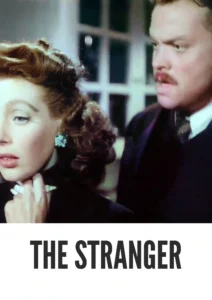Contact: info@alwanfilm.com
Video Sources 0 Views
- Watch trailer
- The Stranger


Synopsis
Table of Contents
ToggleReview: The Stranger 1946 Colorized – A Classic Tale of Suspense and Redemption

Introduction
The Stranger, released in 1946, is a gripping film noir directed by Orson Welles. Known for its tense atmosphere, intricate plot, and stellar performances, this classic thriller continues to captivate audiences with its exploration of guilt, redemption, and the consequences of war. In this review, we’ll delve into the haunting world of The Stranger and its enduring impact on cinema.
Check The Full Colorized Movies List
Check Our Colorized Movies Trailer Channel
Understanding The Stranger 1946 Colorized: Director, Cast, and Genre
Directed by Orson Welles, The Stranger features a talented cast including Edward G. Robinson, Orson Welles himself, and Loretta Young. The film belongs to the film noir genre, characterized by its shadowy visuals, morally ambiguous characters, and atmospheric storytelling.
Exploring the World of The Stranger 1946 Colorized: Plot and Characters
The Stranger follows the story of Mr. Wilson, a war crimes investigator, who is tasked with tracking down a notorious Nazi fugitive hiding in a small American town. As Wilson delves deeper into the investigation, he becomes ensnared in a web of deceit and betrayal, leading to a thrilling climax that forces him to confront his own demons and question the nature of justice.
The Art of Film Colorization
While The Stranger was originally filmed in black and white, its early colorized version adds a new layer of depth to its atmospheric visuals. The colorization process enhances the film’s shadowy atmosphere and captures the nuances of its morally complex characters with striking clarity.
Early Colored Films: A Brief History
The history of early colored films is marked by innovation and experimentation as filmmakers sought to enhance the visual appeal of their movies. From hand-tinted frames to pioneering technicolor processes, the evolution of colorization techniques transformed the cinematic landscape, offering audiences a new way to experience the darkness and intensity of film noir.
The Stranger (1946) and Its Early Colored Version
The decision to release The Stranger in a colorized format was made with the intention of immersing audiences in the atmospheric world of the film and enhancing its visual impact. While some purists may prefer the original black and white version, the early colorized edition of The Stranger adds a new layer of depth to its shadowy atmosphere and captures the moral ambiguity of its characters with breathtaking clarity.
The Debate Over Film Colorization
The debate over film colorization continues to divide audiences and industry professionals alike. While some argue that colorization breathes new life into classic films and makes them more accessible to modern audiences, others maintain that it compromises the artistic integrity of the original work. As technology advances and filmmaking techniques evolve, the debate over colorization remains a topic of ongoing discussion within the film community.
Examining The Stranger (1946) as an Early Colored Film
Viewing The Stranger in its early colorized iteration offers audiences a fresh perspective on its atmospheric visuals and morally complex characters. The colorization process enhances the film’s shadowy atmosphere and captures the tension and suspense of its narrative with stunning clarity. As viewers are drawn into the dark and twisted world of Mr. Wilson and his pursuit of justice, they are treated to a visual feast that immerses them in the haunting beauty of film noir.
Influence and Legacy: The Stranger 1946 Colorized’s Impact on Cinema
The Stranger is widely regarded as a classic of the film noir genre that continues to influence filmmakers and inspire new generations of cinephiles. Its tense atmosphere, intricate plot, and morally complex characters have left an indelible mark on cinema, shaping the way suspense thrillers are made and appreciated to this day.
Director’s Cinematic Legacy: Beyond The Stranger 1946 Colorized
Orson Welles’s directorial legacy extends far beyond The Stranger, encompassing a diverse body of work that includes acclaimed films such as Citizen Kane and Touch of Evil. As one of the most innovative filmmakers of his generation, Welles was known for his ability to craft visually stunning films that explored the complexities of the human condition with depth and nuance. The Stranger stands as a testament to his talent and creativity, solidifying his reputation as one of the great auteurs of classic Hollywood cinema.
Themes Explored in The Stranger 1946 Colorized
At its core, The Stranger explores themes of guilt, redemption, and the consequences of war in the aftermath of World War II. Through its morally complex characters and tense atmosphere, the film offers a nuanced portrayal of the human condition, challenging viewers to confront their own beliefs about justice and morality as they navigate the dark and treacherous world of post-war America.
Reception and Controversy Surrounding The Stranger 1946 Colorized
Upon its release, The Stranger received widespread critical acclaim for its tense atmosphere, intricate plot, and stellar performances. While the decision to release the film in a colorized format sparked debate among purists, its enduring popularity has cemented its status as a timeless classic of the film noir genre.
Where to Watch The Stranger 1946 Colorized Online
For those eager to experience The Stranger for themselves, the film is readily available on popular streaming platforms such as Amazon Prime Video, Google Play Movies, and iTunes. Whether viewed in its original black and white format or its early colorized iteration, The Stranger offers a cinematic experience that is both gripping and visually stunning.
FAQs About The Stranger 1946 Colorized
1. Is The Stranger based on a true story?
No, The Stranger is a fictional film that explores the themes of guilt, redemption, and the consequences of war through the eyes of its morally complex characters. While the film’s storyline may draw inspiration from real-life events, its characters and plot are works of fiction.
2. Who starred in The Stranger?
The Stranger stars Edward G. Robinson as Mr. Wilson, a war crimes investigator tasked with tracking down a notorious Nazi fugitive hiding in a small American town. He is supported by Orson Welles, who delivers a memorable performance as the enigmatic fugitive, Franz Kindler, and Loretta Young as the unsuspecting wife caught in the midst of their deadly game of cat and mouse.
3. What is the central message of The Stranger?
At its core, The Stranger explores themes of guilt, redemption, and the consequences of war in the aftermath of World War II. Through its morally complex characters and tense atmosphere, the film offers a nuanced portrayal of the human condition, challenging viewers to confront their own beliefs about justice and morality as they navigate the dark and treacherous world of post-war America.
4. Why was The Stranger released in a colorized format?
The decision to release The Stranger in a colorized format was made with the intention of immersing audiences in the atmospheric world of the film and enhancing its visual impact. While some purists may prefer the original black and white version, the early colorized edition of The Stranger adds a new layer of depth to its shadowy atmosphere and captures the moral ambiguity of its characters with breathtaking clarity.
5. What is the legacy of The Stranger?
The Stranger is widely regarded as a classic of the film noir genre that continues to influence filmmakers and inspire new generations of cinephiles. Its tense atmosphere, intricate plot, and morally complex characters have left an indelible mark on cinema, shaping the way suspense thrillers are made and appreciated to this day.
6. Are there any sequels or remakes of The Stranger?
No, there have been no official sequels or remakes of The Stranger. However, the film’s enduring popularity has inspired countless reinterpretations and homages in various media. Nonetheless, none have captured the tense atmosphere and moral complexity of the original 1946 classic.
7. Where can I watch The Stranger online?
For those eager to experience The Stranger for themselves, the film is readily available on popular streaming platforms such as Amazon Prime Video, Google Play Movies, and iTunes. Whether viewed in its original black and white format or its early colorized iteration, The Stranger offers a cinematic experience that is both gripping and visually stunning.
Conclusion
In conclusion, The Stranger (1946) stands as a classic of the film noir genre that continues to captivate audiences with its tense atmosphere, intricate plot, and morally complex characters. Whether viewed in its original black and white format or its early colorized iteration, Orson Welles’s insightful direction and the stellar performances of the cast offer a cinematic experience that is both gripping and visually stunning. As viewers are drawn into the dark and twisted world of Mr. Wilson and his pursuit of justice, they are treated to a visceral journey that challenges their beliefs about guilt, redemption, and the consequences of war. The Stranger remains a timeless classic that continues to enthrall and inspire audiences around the world.



















